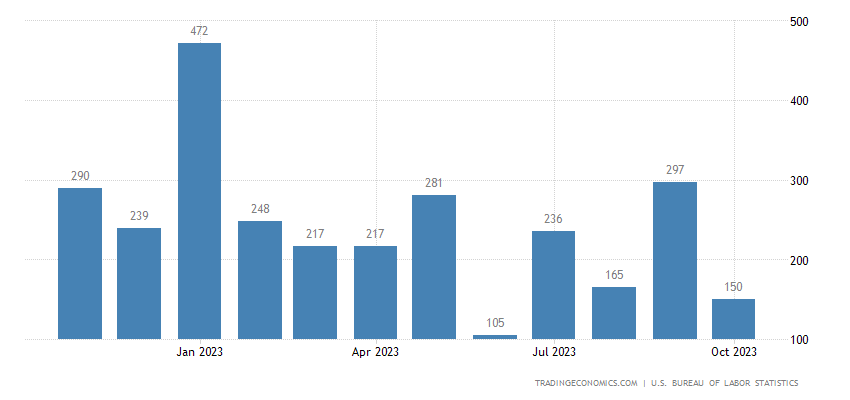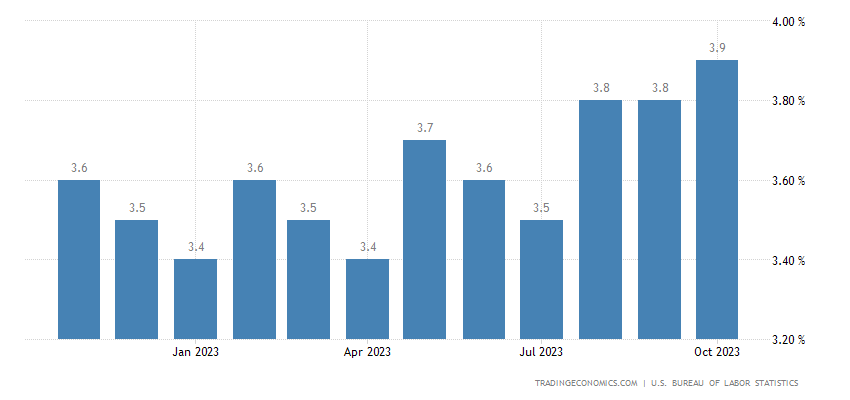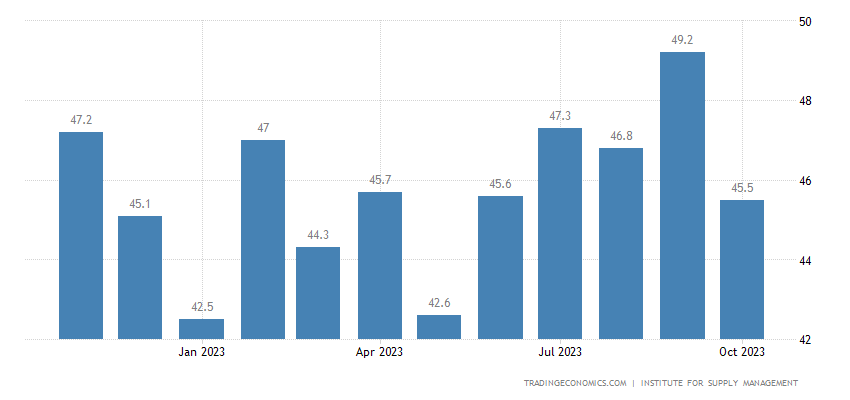How to trade on No-Interest-Hike anymore?
Last week, there were some changes in the macroeconomic data in the United States.
In October, there were 150,000 new non-farm jobs, which was lower than the market expectation of 180,000. A significant part of this was due to a decline of 35,000 jobs in the manufacturing sector, mainly reflecting the impact of the strike by American auto workers. This is expected to be corrected in November.

At the same time, the employment data for August and September were also revised down, indicating that the previous two months were too optimistic, which is reflected in the October data. In addition, the unemployment rate increased by 0.1 percentage points to 3.9% compared to the previous month, and the growth rate of hourly wages increased by 0.2%, providing evidence of a slowdown.

The ISM Manufacturing PMI fell from 49 last month to 46.7, and the Services PMI also fell from 53.6 last month to 51.8. This may be due to factors such as rising US bond yields in October, ongoing strikes, global energy price increases, and the resurfacing of uncertainties related to the Israeli-Palestinian conflict, all of which have dampened business sentiment.

Does the downward economic data indicate disappearace of economic soft-landing? ?
We believe not. A soft landing for the US economy is still a highly probable event.
Firstly, the strike has ended, although there are sporadic voices suggesting future targets such as Tesla and Toyota by the UAW, it is unlikely to create a bigger wave.
Secondly, oil prices have not further increased, the impact of Russia-Ukraine conflict has almost disappeared, and the Israeli-Palestinian conflict is not a prolonged war. Additionally, winter is not a peak travel season, and the decline in manufacturing PMI will also put pressure on upstream raw materials.
More importantly, at the November FOMC meeting, the Federal Reserve revealed a non-urgent attitude towards raising interest rates and stated that it will proceed more cautiously, carefully balancing various risks. Investors quickly changed their expectations and leaned towards a dovish stance, believing that the Fed will stop tightening and may even cut interest rates by 100 basis points by the end of 2024...
At the same time, the US Treasury's debt issuance plan is also somewhat positive. The net issuance volume for Q4 2023 is lower than the original plan, which is relatively favorable for the current situation of oversupply and insufficient demand. Furthermore, as US-China relations improve and the possibility of Japan's exit from yield curve control and negative interest rates increases, there will be more international buyers in the US bond market.
Will the Federal Reserve get what it wants? How should investors trade?
In fact, according to Powell's meaning, if market financial conditions can be maintained at the current level (relatively tight), economic cooling will be achieved by suppressing new additions and allowing stock to slowly decline. This would also achieve the Fed's goal of exchanging time for space (high for longer), so there is no need for further interest rate hikes.
However, betting excessively on loose monetary policy may pose obstacles to the Fed's fight against inflation if interest rates decrease too much and financial conditions become too loose. The Fed may still take other actions.
Therefore, if there are some liquidity factors in the short-term pricing, the repair of fundamentals and the degree of "soft landing" in the macro environment are still the core concerns.
At present, it is still too early to completely turn for the better. From the Q3 earnings season data, some companies have already shown a slowing upward momentum in their guidance for Q4 and 2024. Instead of chasing high, it is better to focus on volitilaty based on current fundamentals.
Disclaimer: Investing carries risk. This is not financial advice. The above content should not be regarded as an offer, recommendation, or solicitation on acquiring or disposing of any financial products, any associated discussions, comments, or posts by author or other users should not be considered as such either. It is solely for general information purpose only, which does not consider your own investment objectives, financial situations or needs. TTM assumes no responsibility or warranty for the accuracy and completeness of the information, investors should do their own research and may seek professional advice before investing.
- Bella127·2023-11-07Good article 👍LikeReport
- YueShan·2023-11-06Good ⭐️⭐️⭐️LikeReport

